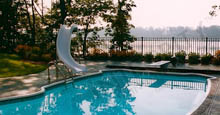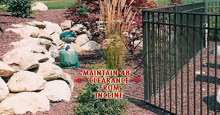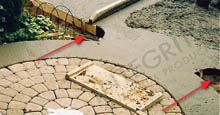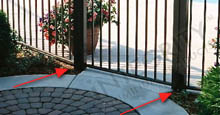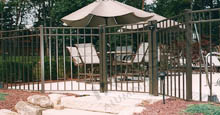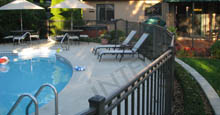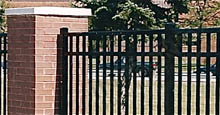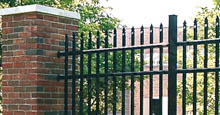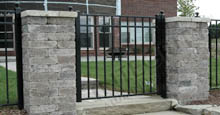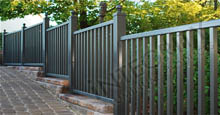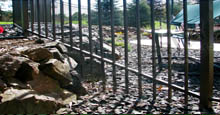Aluminum Fences | DIY Project Tips for Success from iFence
On this page, we offer a brief overview of challenges that may need to be addressed before embarking on a DIY fencing project. Some helpful tips are also presented to spark your creativity, but we don't go into the fine details and planning of your overall landscaping. That we leave to you and the professionals who may share with us the privilege of serving you.
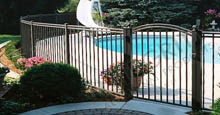
Unobstructed View

The best attribute of Integrity™ aluminum fences is that your view is not obstructed by the fence. This means you can easily keep an eye on the pool area. Beyond your yard there may be a beautiful lake, a wooded area, or just wild flowers. Integrity™ aluminum fences let you continue to enjoy your surroundings with minimal obstruction, especially when ordered in bronze or black. When privacy is important, we recommend landscaping with natural foliage as a barrier on either side of your Integrity™ fence. Most local codes do not permit privacy fences taller than 6', which means you'll be boxed in while others from a distance may still be able to look in. Take a look at our extensive photo gallery and then ask yourself, ''How could a big tall plastic wall be this attractive?''

The best attribute of Integrity™ aluminum fences is that your view is not obstructed by the fence. This means you can easily keep an eye on the pool area. Beyond your yard there may be a beautiful lake, a wooded area, or just wild flowers. Integrity™ aluminum fences let you continue to enjoy your surroundings with minimal obstruction, especially when ordered in bronze or black. When privacy is important, we recommend landscaping with natural foliage as a barrier on either side of your Integrity™ fence. Most local codes do not permit privacy fences taller than 6', which means you'll be boxed in while others from a distance may still be able to look in. Take a look at our extensive photo gallery and then ask yourself, ''How could a big tall plastic wall be this attractive?''
Keep Fence Clear of Objects or Grade Inclines

Always remember that when a pool is involved, fences are subject to more restrictions for the safety of children. Please take the time to review our pool safety link. Integrity Aluminum Products™ places a high priority on safety and we want you to be aware of potential hazards for children. For instance, keeping fences a safe distance away from objects outside the pool area such as air conditioner units is addressed by the BOCA pool safety code and is almost universally enforced by inspectors. This is a good idea for the protection of children. When retaining walls are involved and it is not possible to maintain adequate clearance from the incline, consider installing your fence on the high ground! All of our Resort Collection™ pool fences comply with the rigid safety standards of BOCA!*

Always remember that when a pool is involved, fences are subject to more restrictions for the safety of children. Please take the time to review our pool safety link. Integrity Aluminum Products™ places a high priority on safety and we want you to be aware of potential hazards for children. For instance, keeping fences a safe distance away from objects outside the pool area such as air conditioner units is addressed by the BOCA pool safety code and is almost universally enforced by inspectors. This is a good idea for the protection of children. When retaining walls are involved and it is not possible to maintain adequate clearance from the incline, consider installing your fence on the high ground! All of our Resort Collection™ pool fences comply with the rigid safety standards of BOCA!*
How Wide Should A Walkway Be?

When planning your walkway, keep in mind that the gate needs to be wide enough so that you are able to install the gate posts on each side of the concrete, therefore, we recommend leaving yourself a little extra space. For instance, if you are going to have a 48' wide gate, an ideal limit for the width of your walkway is 45''. Pavers can be more forgiving, but it's still better to plan ahead, as shown. Usually, the fence is ordered in advance of the installation of the concrete, so you'll want to go over this point with the concrete installers. Don't assume anything! Talking about these details with your concrete professional will ensure the success of your project! One last thing, when hugging the concrete with your fence, there is a key point to remember. Often, when the concrete is angled and not square with the gate, the gate itself needs to be made wider to span the distance! This issue is resolved in one of three ways, by narrowing the walkway, by widening the gate, or installing the gate square with the concrete and then angling the adjacent fencing. Advise your contractor of your decision! Of course, at times mounting posts directly onto concrete will be necessary. Our FAQ link addresses these circumstances and the best way to plan for success!

When planning your walkway, keep in mind that the gate needs to be wide enough so that you are able to install the gate posts on each side of the concrete, therefore, we recommend leaving yourself a little extra space. For instance, if you are going to have a 48' wide gate, an ideal limit for the width of your walkway is 45''. Pavers can be more forgiving, but it's still better to plan ahead, as shown. Usually, the fence is ordered in advance of the installation of the concrete, so you'll want to go over this point with the concrete installers. Don't assume anything! Talking about these details with your concrete professional will ensure the success of your project! One last thing, when hugging the concrete with your fence, there is a key point to remember. Often, when the concrete is angled and not square with the gate, the gate itself needs to be made wider to span the distance! This issue is resolved in one of three ways, by narrowing the walkway, by widening the gate, or installing the gate square with the concrete and then angling the adjacent fencing. Advise your contractor of your decision! Of course, at times mounting posts directly onto concrete will be necessary. Our FAQ link addresses these circumstances and the best way to plan for success!
Remember the Landing!

If there are steps leading up to your gate, there should (and often must) be an adequate landing otherwise it becomes awkward to open the gate. A person must have plenty of room to maneuver when opening the gate. This issue, if not addressed early enough, may result in a costly reworking of landscaping, including retaining walls. Or, as pictured here, a reluctant angling inward with some concrete coring in order to create a landing space. Though not as initially conceived, the homeowner was able to avoid serious aesthetic compromise.

If there are steps leading up to your gate, there should (and often must) be an adequate landing otherwise it becomes awkward to open the gate. A person must have plenty of room to maneuver when opening the gate. This issue, if not addressed early enough, may result in a costly reworking of landscaping, including retaining walls. Or, as pictured here, a reluctant angling inward with some concrete coring in order to create a landing space. Though not as initially conceived, the homeowner was able to avoid serious aesthetic compromise.
Consider a Rounded Configuration

Curved fencing layouts can be gorgeous! And Integrity™ aluminum fences will flow with these curves quite well! You do not have to lock yourself into a rectangular pattern. As Integrity™ fence panels are being installed, they can be shifted directionally. While the panels themselves are not rounded or bent, the cumulative effect of this slight adjustment at each post creates a rounded effect. The curve appeal shown here is very effective, don't you think?

Curved fencing layouts can be gorgeous! And Integrity™ aluminum fences will flow with these curves quite well! You do not have to lock yourself into a rectangular pattern. As Integrity™ fence panels are being installed, they can be shifted directionally. While the panels themselves are not rounded or bent, the cumulative effect of this slight adjustment at each post creates a rounded effect. The curve appeal shown here is very effective, don't you think?
When Attaching to Pillars

Pillars are a lovely way to achieve a stately look, and they work well with Integrity™ aluminum fences. There are two ways to terminate a fence run up against a pillar. First, an end post can be installed butted up to the pillar, as shown. If this is the look that you're seeking, be sure the foundation of the pillar does not protrude beyond the outer plane of the pillar. Otherwise, you will not be able to install the post close enough to the pillar. You may have to cut the post to just below grade, and then attach it directly to the pillar. Or, if you prefer, you can eliminate the post altogether and use rail mounting brackets, as shown. Regardless of your chosen method, we recommend that the height of the pillar always be approximately 6 inches higher than your fence, not including the capstone. Why? Integrity™ cuts no corners. All fence panels are actually the height we say they are, not an approximate!

Pillars are a lovely way to achieve a stately look, and they work well with Integrity™ aluminum fences. There are two ways to terminate a fence run up against a pillar. First, an end post can be installed butted up to the pillar, as shown. If this is the look that you're seeking, be sure the foundation of the pillar does not protrude beyond the outer plane of the pillar. Otherwise, you will not be able to install the post close enough to the pillar. You may have to cut the post to just below grade, and then attach it directly to the pillar. Or, if you prefer, you can eliminate the post altogether and use rail mounting brackets, as shown. Regardless of your chosen method, we recommend that the height of the pillar always be approximately 6 inches higher than your fence, not including the capstone. Why? Integrity™ cuts no corners. All fence panels are actually the height we say they are, not an approximate!
How Tall Should A Pillar Be?

What should be your pillar height for a 54'' fence, as an example? First, your fence will likely be installed two inches off grade. We just inched up to 56'' (from grade to the top of the fence panel). But we're not done with the math yet! The top of the post is always one inch higher than the top of the panel, and the standard post cap adds another 3/4''. Now, we are at nearly 58'' off grade. In this scenario we recommend a 60'' to 62'' pillar height not including the capstone, taller still if you intend to use ball caps! Of course, if you are using rail mounting brackets and a post is not being butted up to the pillar, you may have some wiggle room. But remember, if your pillar is too short (as shown), aesthetics have been compromised in two ways. First, a pillar shorter than the fence has the look and feel of a mistake. Second, the fence cannot be butted up to the pillar without making unsightly cuts into the capstone which is generally extended beyond the planes of the pillar!

What should be your pillar height for a 54'' fence, as an example? First, your fence will likely be installed two inches off grade. We just inched up to 56'' (from grade to the top of the fence panel). But we're not done with the math yet! The top of the post is always one inch higher than the top of the panel, and the standard post cap adds another 3/4''. Now, we are at nearly 58'' off grade. In this scenario we recommend a 60'' to 62'' pillar height not including the capstone, taller still if you intend to use ball caps! Of course, if you are using rail mounting brackets and a post is not being butted up to the pillar, you may have some wiggle room. But remember, if your pillar is too short (as shown), aesthetics have been compromised in two ways. First, a pillar shorter than the fence has the look and feel of a mistake. Second, the fence cannot be butted up to the pillar without making unsightly cuts into the capstone which is generally extended beyond the planes of the pillar!
What About Sudden Changes in Grade?

Retaining walls are often necessary due to unavoidable sudden changes in grade. When planned correctly, these conditions will add to the landscape's beauty. Where the Integrity™ fence will be installed is where we can offer advice. First, when possible, try to install the fence on the high ground. Occasionally, it is necessary to ''hop over'' a retaining wall, as shown. In this case, you'll end up using Max-Rack™ panels and possibly custom protruding pickets, as shown. If the retaining wall is more of a wall, as in suddenly stepping the grade up, this usually requires stepping the fence, also as shown. Either way, we will advise a cost-effective custom solution.

Retaining walls are often necessary due to unavoidable sudden changes in grade. When planned correctly, these conditions will add to the landscape's beauty. Where the Integrity™ fence will be installed is where we can offer advice. First, when possible, try to install the fence on the high ground. Occasionally, it is necessary to ''hop over'' a retaining wall, as shown. In this case, you'll end up using Max-Rack™ panels and possibly custom protruding pickets, as shown. If the retaining wall is more of a wall, as in suddenly stepping the grade up, this usually requires stepping the fence, also as shown. Either way, we will advise a cost-effective custom solution.
When Pavers Are Involved

When fencing is installed through an area to be paved, as shown, pavers are much more forgiving than concrete. In other words, even after they have been installed, a few can be extracted so that a fence post can be installed. Afterwards, with a little cutting, they can be reinserted. As always, plan ahead so that the fence is installed before the pavers go in. One last note, if the walkway is to be a paver walkway, remember to account for the paver edging when determining the size of your gate opening. You will want to install your gate without disturbing the edging structure or you will end up with shifting pavers down the road!

When fencing is installed through an area to be paved, as shown, pavers are much more forgiving than concrete. In other words, even after they have been installed, a few can be extracted so that a fence post can be installed. Afterwards, with a little cutting, they can be reinserted. As always, plan ahead so that the fence is installed before the pavers go in. One last note, if the walkway is to be a paver walkway, remember to account for the paver edging when determining the size of your gate opening. You will want to install your gate without disturbing the edging structure or you will end up with shifting pavers down the road!
* Before ordering Integrity™ aluminum fencing, we urge you to check with your local governing authority regarding pool fence legal codes. These codes often vary from one community to another. If a permit is required, we recommend you obtain the permit before ordering your Integrity™ fence. We will provide the specifications you need to determine compliance. Although iFenceUSA™ would love to be current on local codes for your convenience, there are simply too many. Therefore, we will not be accountable for orders that are subsequently deemed noncompliant.











